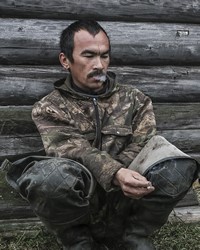The Siberian Tatars have a long history. Their ancestors lived in western Siberia before the end of the sixteenth century, when Russian immigrants came to the area. Today there are about 200,000 Siberian Tatars, who live primarily in valleys between Russia's Ural Mountains and the Yenisei River. The Tatars are a mix of many European ethnic groups, but are predominantly Turkic and are descendants of the Kypchak people.
The Tatars and the Russians have historically struggled to have a good relationship. The earliest Tatar government was the Tinmen Khanate, which was formed in the fourteenth century. This government lasted until 1582, when the Russia military destroyed it. This hurt the Tatars and gave Russians a low view of them. As time passed, the Russians and Tatars repaired their relationship to some extent.
The Tatars are known for their trade. The merchant class has been a strong group among the Tatars through the centuries, and they are experts at trading.
The aboriginal Siberian Tatars consist of three large ethnic groups, each of which has further subdivisions. The Tomsk Tatars are composed of the Kalmaks, the Chats, and the Eushta. They live along the Tomi and Ob rivers in the Tomsk District, and, in part, in the Kemerovsk and Novosibirsk districts. Among the Barabinsk Tatars, scholars have recently distinguished the following subgroups: the Barabo-Turashi, the Terenino-Choi, and the Liubei-Tunusy. They are settled in the Barabinsk steppe and the Novosibirsk region. The most numerous group, the Tobolo-Irtysh, consists of the Tars, Kurdak-Sargatsk, Tobolsk, Tiumen, and Iaskolbin Tatars. They live in the basins of the Irtysh and Tobol rivers in the Omsk and Tyumensk districts of Russia.
The lives of the Siberian Tatars in today's world are generally modern. Living conditions are similar to those of neighboring populations (Russia, Bashirks, and Ukrainians). Tatars usually live near a river, which allows them to catch and eat fish as a significant part of their diet. The Tatar diet consists of a variety of foods. The most widespread include milk products and meats, such as horsemeat, mutton, elk, rabbit, and much more. They enjoy occasional meals from restaurants.
Traditional Tatar occupations are varied. Tatar craftspeople make leather, do woodwork, and make handcrafts. Some Tatars make fishing nets and baskets. They conduct a lot of trade and transportation as well. Other Tatar jobs include, but are not limited to, carpenters, jewelers, and cobblers.
Tatar education has a close historical connection with Islam. In the nineteenth century Shihabeddin Merdžani, his student Hussein Feizhani, and Kajum Nasyri opened a madrassa that focused on the culture of Islam as well as the Koran and its teachings. After Feizhani's death, his plan became standard for the Tatar madrassa. Nasyri wrote the textbooks, calendars, and most literature for these madrassas. He translated literature from Russian to the Tatar, and vice versa. Nasyri also created a written Tatar grammar and vocabulary, leading to a better education for the Siberian Tatars.
Historically, Tatar women were considered subordinate to men. Women did not have much freedom, even to choose their husbands. They were traditionally married at a young age. Today the situation is different; husband and wife are considered equal in marriage. They both receive the same share and have freedom.
The Siberian Tatars enjoy storytelling. Folklore has been a big part of their lives for centuries. They enjoy performances, including singing and dancing. They also tell proverbs that have been passed down for generations. It is not surprising that the Tatars also enjoy the arts and theater. Effective methods to share the gospel with this people group might include storytelling, plays, and songs.
The Siberian Tatars are 95% Sunni Muslim and 5% non-religious. Most Tatars visit mosques and worship Allah. They participate in many Muslim traditions, including fasting and not eating certain foods. Although they are mostly Muslim, the Tatars incorporate indigenous traditions into their faith as well. Many Tatars believe in spirits and cults of nature and animals, which have been a part of their tradition for a long time.
They often mix traditional religious elements with Islam to create a unique set of beliefs and practices.
The Tatars are set in their Muslim ways, so their needs include someone who knows Islam and its culture and can help them navigate the path to Christianity. The Tatars also experience religious syncretism, due to the mixture of their traditions with Islam. They need leaders to help them sort out religious truth and properly contextualize the Christian faith without falling into a different form of syncretism.
Pray that the Tatars' eyes and hearts open up to Christianity, even though they are set on their faith of Islam.
Pray that Russians and Siberian Tatars continue to improve their relationship and that their past struggles will not be repeated.
Pray that the Tatars become a reached people group and are able to spread the Gospel to those around them.
Scripture Prayers for the Tobol-Irtysh Tatar, Siberian in Russia.
Location information from an anonymous source.
| Profile Source: Julie Jo Yarbro |










